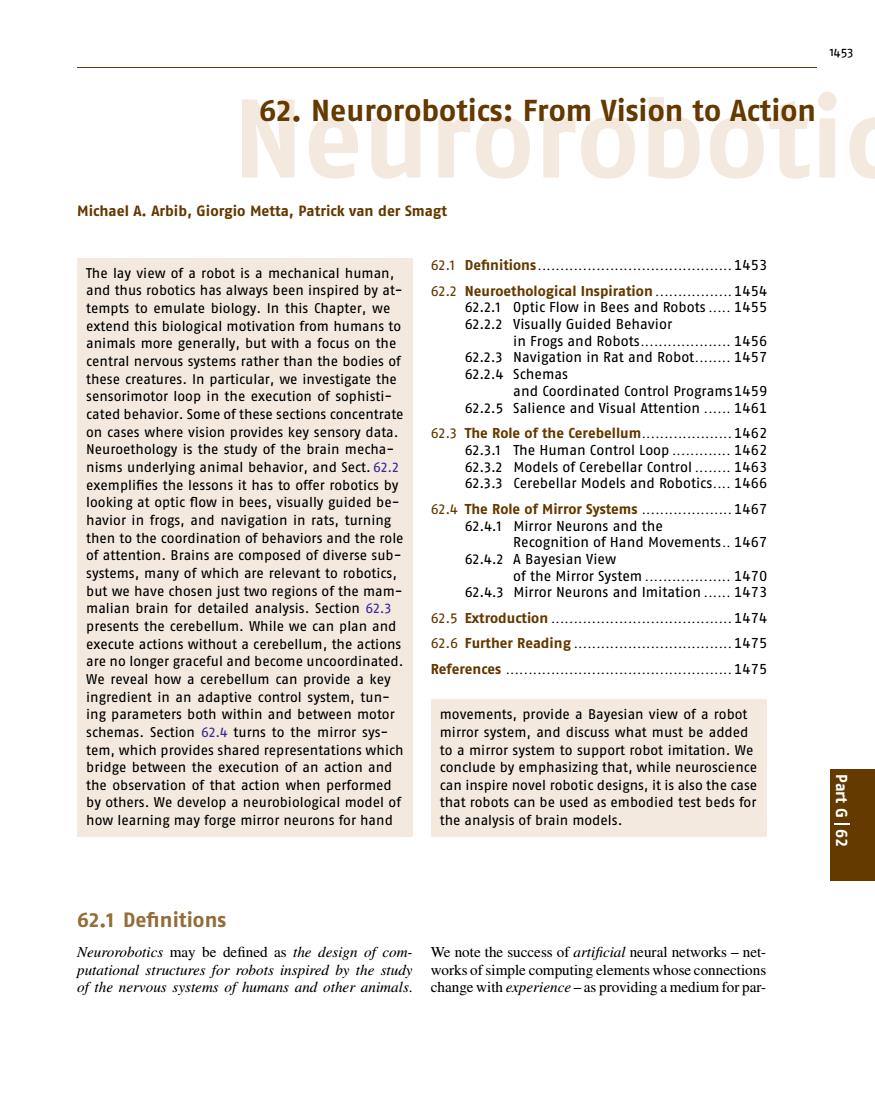正在加载图片...

1453 62.Neurorobotics:From Vision to Action Michael A.Arbib,Giorgio Metta,Patrick van der Smagt The lay view of a robot is a mechanical human, 62.1 Definitic0n5...1453 and thus robotics has always been inspired by at- 62.2 Neuroethological Inspiration.... ..1454 tempts to emulate biology.In this Chapter,we 62.2.1 Optic Flow in Bees and Robots.....1455 extend this biological motivation from humans to 62.2.2 Visually Guided Behavior animals more generally,but with a focus on the in Frogs and Robots........ .1456 central nervous systems rather than the bodies of 62.2.3 Navigation in Rat and Robot........1457 these creatures.In particular,we investigate the 62.2.4 Schemas sensorimotor loop in the execution of sophisti- and Coordinated Control Programs1459 cated behavior.Some of these sections concentrate 62.2.5 Salience and Visual Attention......1461 on cases where vision provides key sensory data. 62.3 The Role of the Cerebellum....................1462 Neuroethology is the study of the brain mecha- 62.3.1 The Human Control Loop..............1462 nisms underlying animal behavior,and Sect.62.2 62.3.2 Models of Cerebellar Control........1463 exemplifies the lessons it has to offer robotics by 62.3.3 Cerebellar Models and Robotics....1466 looking at optic flow in bees,visually guided be- 62.4 The Role of Mirror Systems .1467 havior in frogs,and navigation in rats,turning 62.4.1 Mirror Neurons and the then to the coordination of behaviors and the role Recognition of Hand Movements..1467 of attention.Brains are composed of diverse sub- 62.4.2 A Bayesian View systems,many of which are relevant to robotics, of the Mirror System................1470 but we have chosen just two regions of the mam- 62.4.3 Mirror Neurons and Imitation......1473 malian brain for detailed analysis.Section 62.3 presents the cerebellum.While we can plan and 62.5 Extroduction........1474 execute actions without a cerebellum,the actions 62.6 Further Reading.... .1475 are no longer graceful and become uncoordinated. References................... 1475 We reveal how a cerebellum can provide a key ingredient in an adaptive control system,tun- ing parameters both within and between motor movements,provide a Bayesian view of a robot schemas.Section 62.4 turns to the mirror sys- mirror system,and discuss what must be added tem,which provides shared representations which to a mirror system to support robot imitation.We bridge between the execution of an action and conclude by emphasizing that,while neuroscience the observation of that action when performed can inspire novel robotic designs,it is also the case by others.We develop a neurobiological model of that robots can be used as embodied test beds for Part how learning may forge mirror neurons for hand the analysis of brain models. 62.1 Definitions Neurorobotics may be defined as the design of com-We note the success of artificial neural networks-net- putational structures for robots inspired by the study works of simple computing elements whose connections of the nervous systems of humans and other animals. change with experience-as providing a medium for par-1453 Neurorobotics 62. Neurorobotics: From Vision to Action Michael A. Arbib, Giorgio Metta, Patrick van der Smagt The lay view of a robot is a mechanical human, and thus robotics has always been inspired by attempts to emulate biology. In this Chapter, we extend this biological motivation from humans to animals more generally, but with a focus on the central nervous systems rather than the bodies of these creatures. In particular, we investigate the sensorimotor loop in the execution of sophisticated behavior. Some of these sections concentrate on cases where vision provides key sensory data. Neuroethology is the study of the brain mechanisms underlying animal behavior, and Sect. 62.2 exemplifies the lessons it has to offer robotics by looking at optic flow in bees, visually guided behavior in frogs, and navigation in rats, turning then to the coordination of behaviors and the role of attention. Brains are composed of diverse subsystems, many of which are relevant to robotics, but we have chosen just two regions of the mammalian brain for detailed analysis. Section 62.3 presents the cerebellum. While we can plan and execute actions without a cerebellum, the actions are no longer graceful and become uncoordinated. We reveal how a cerebellum can provide a key ingredient in an adaptive control system, tuning parameters both within and between motor schemas. Section 62.4 turns to the mirror system, which provides shared representations which bridge between the execution of an action and the observation of that action when performed by others. We develop a neurobiological model of how learning may forge mirror neurons for hand 62.1 Definitions ........................................... 1453 62.2 Neuroethological Inspiration ................. 1454 62.2.1 Optic Flow in Bees and Robots ..... 1455 62.2.2 Visually Guided Behavior in Frogs and Robots.................... 1456 62.2.3 Navigation in Rat and Robot........ 1457 62.2.4 Schemas and Coordinated Control Programs1459 62.2.5 Salience and Visual Attention ...... 1461 62.3 The Role of the Cerebellum.................... 1462 62.3.1 The Human Control Loop ............. 1462 62.3.2 Models of Cerebellar Control ........ 1463 62.3.3 Cerebellar Models and Robotics.... 1466 62.4 The Role of Mirror Systems .................... 1467 62.4.1 Mirror Neurons and the Recognition of Hand Movements.. 1467 62.4.2 A Bayesian View of the Mirror System ................... 1470 62.4.3 Mirror Neurons and Imitation ...... 1473 62.5 Extroduction ........................................ 1474 62.6 Further Reading ................................... 1475 References .................................................. 1475 movements, provide a Bayesian view of a robot mirror system, and discuss what must be added to a mirror system to support robot imitation. We conclude by emphasizing that, while neuroscience can inspire novel robotic designs, it is also the case that robots can be used as embodied test beds for the analysis of brain models. 62.1 Definitions Neurorobotics may be defined as the design of computational structures for robots inspired by the study of the nervous systems of humans and other animals. We note the success of artificial neural networks – networks of simple computing elements whose connections change with experience – as providing a medium for parPart G 62